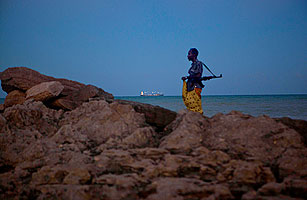
Guarding the Loot A pirate in the Somalian town of Hobyo stands against the backdrop of a hijacked Greek freighter
(2 of 4)
According to the Kuala Lumpur — based International Maritime Bureau, Somali pirates attacked 117 ships in the first three months of 2011. That's an all-time high, more than double the figure for the same period last year, raising the number of ships held in Somalia to 28 and sailors to 600. (The totals for the past decade are 160 ships and 4,000 sailors.) The pirates are increasing not just the frequency of their attacks but also their range. They now take ships across the Indian Ocean as far south as Mozambique, as far north as the United Arab Emirates and as far east as India. An area that large is all but impossible to police. And just as they always did, the pirates are targeting an artery of world trade: 40% of global seaborne trade, or 300 cargo ships a day, makes the passage between East and West through the Indian Ocean. That means the ransoms paid to the pirates by shipowners and their insurers are a mere fraction of piracy's true cost. Risk consultancy Geopolicity said in May that higher insurance premiums, extra security, longer routes taken to avoid attacks and the consequent rise in prices of goods transported added up to anywhere from $4.9 billion to $8.3 billion.
Increasingly, there is a price to be paid in blood as well. Whereas Somali pirates once rarely used violence, from January to March they killed seven sailors. Shippers also report frequent beatings and torture of sailors, even a few instances of keelhauling. The rise in bloodshed is explained partly by the pirates' discovery that it speeds and raises ransoms and partly by the increasingly lethal nature of contacts between pirates and foreign warships belonging to a 25-nation antipiracy armada. In January, South Korean commandos killed eight pirates while rescuing 21 hostages from a hijacked freighter. In February, as U.S. forces closed in, pirates shot dead four American hostages who had been on an around-the-world sailing trip. When forces from Puntland, a semiautonomous region of northern Somalia, tried to free a Danish yachting couple, their three children ages 13 to 17 and two other adults in March, another group of pirates killed five of the soldiers. In May, a Taiwanese skipper was killed in a shoot-out between pirates and the U.S.S. Stephen W. Groves, a frigate that is part of the antipiracy patrol.
Press-Ganged
A few days before I meet Fingers, I hear a firsthand account of the pirates' growing industriousness in a Kenyan café on the edge of Mombasa's old town. Last year, Joseck Amere was one of 39 Kenyans crewing for a South Korean captain on the Golden Wave, a 300-ton, 85-m trawler fishing for tuna, crab, lobster and prawns off Kenya's northern coast. Just after dawn on Sept. 9, Amere saw two skiffs skid across the horizon. He fetched some binoculars. "I can see five or six guys, and they have weapons," he says. "Two RPGs, two heavy machine guns, six AK-47s. They start firing. They signal us to stop. The captain tries to escape, but the pirates put a ladder over the side, climb aboard, run to the wheelhouse and punch the captain. 'If you want your lives, cooperate or we will kill you all,' they say. 'We are not scared of anything. We know we can die any minute, but we'll kill you all first.'"
The pirates sailed for Haradheere, a pirate base a day's drive from Galcayo. There a group of town elders boarded the ship, denounced the crew for stealing Somali fish and told the captain he had three choices: "Cooperate and use your ship to hijack a tanker. Pay us $6 million. Or we'll behead you and sink your boat." The captain chose to hijack a tanker.
Which is how the Golden Wave became a pirate mother ship. For the next six months, using Amere and his crewmates as human shields, the pirates roamed the Indian Ocean. First to fall, on Oct. 24, was a Singapore-flagged, 5,076-ton liquid-natural-gas tanker, the York, boarded at anchor off Mombasa. The Golden Wave then moved to the Seychelles, where, after attempting 17 ambushes in 21 days — all of which failed — the pirates captured a German cargo vessel, the Beluga Nomination, on Jan. 22. The hijack turned violent when the Seychelles coast guard opened fire: one pirate and two crewmen were killed. Two days later, the pirates hijacked an Iranian fishing boat. Then they boarded a Pakistani fishing boat and stole its radio, laptops and fuel. Finally, running low on fuel again, they ambushed a third boat. By this time, Amere said, he was a member of the boarding team, albeit one with a gun to his head.